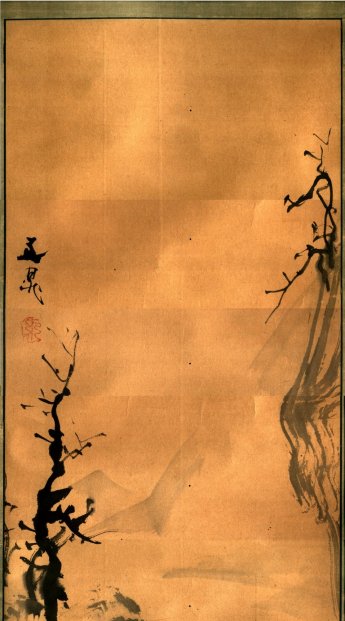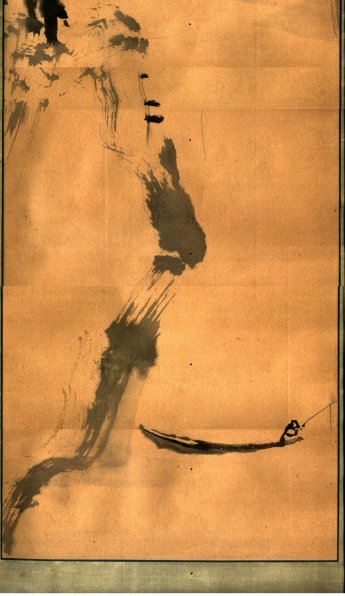Tani Buncho 谷文晁 (1763-1840)
Sekizinci Tokugawa shogununun soyundan gelen Tayasu ailesinin hizmetinde bulunan bir şairin oğlu olarak dünyaya gelen Tani Buncho doğuştan mevki ve imtiyazlara sahipti. Tayasu ailesine mensup olan ve onbirinci shogunun naipliğini yürüten Matsudaira Sadanobu (1758-1829) ile 1792 yılında dostluk kurmaya başlamıştır. Saray ressamı olarak gösterdiği yeterlilik sayesinde bir dizi önemli sipariş alması Buncho'ya Çin ve Japon sanatına ait koleksiyonlara ulaşma ve ülke çapında sanatçılar ile patronlar nezdinde tanınma fırsatı vermiştir.
Resim çalışmaya genç yaşta Kano üslubuyla başlayan Buncho, Kato Buntei (1706-1782) ve Watanabe Gentai (1749-1822)'den ders almıştır.1788'de Batı resim tekniklerini öğrenmek üzere Edo'dan Nagasaki'ye gitmiştir Buncho.Yaptığı yolculuklar sırasında tanıştığı sanat koruyucusu ve müşterisi Kimura Kenkado (1736-1802) ile ömür boyu süren bir dostluk kurmuştur. Kenkado sayesinde Buncho aralarında Uragami Gyokudo ve Yamamoto Baiitsu'nun bulunduğu, Kansai bölgesinde yaşayan nanga sanatçılarıyla tanışma imkanı bulmuştur. Buncho'nun sanatsal eklektisizmi onu Çin, Japon ve Avrupa geleneklerinden oluşan önemli bir üslupsal çeşitliliğe doğru yöneltmiştir. Bununla birlikte Buncho nanga üslubundaki eserleriyle ve bu entelektüel üslubu geleneksel doğum yeri olan Kyoto ve Osaka'dan başkente taşımasındaki rolüyle tanınmıştır.
Kaynakça: Lisa Rotondo-McCord, An Enduring Vision 17th to 20th Century Japanese Painting from the Gitter-Yelen Collection, New Orleans Museum of Art, New Orleans, 2002:239.
Tani Buncho 谷文晁 (1763-1840)
The son of a poet and retainer to the Tayasu family, descendants of the eighth Tokugawa shogun, Tani Buncho was born to status and privilege. In 1792 he began his association with Matsudaira Sadanobu (1758-1829), a member of the Tayasu family, who was serving as regent for the eleventh shogun. In his capacity as an official artist, Buncho was charged with a number of important commissions, which gave him access to collections of Chinese and Japanese art and entrée with artists and patron throughout Japan.
Buncho began his study of painting at a young age in the Kano style with Kato Buntei (1706-1782) and Watanabe Gentai (1749-1822). ıN 1788 Buncho left for Edo to Nagasaki, intending to learn Western painting techniques. During his travels, he met the patron Kimura Kenkado (1736-1802), who became a lifelong friend. Through Kenkado, Buncho met nanga artists in the Kansai area, including Uragami Gyokudo and Yamamoto Baiitsu. Buncho's artistic eclecticism led to a remarkable stylistic range that included Chinese, Japanese and European traditions. Buncho is best known, however, for his work in the nanga style and for his role in bringing the literati style to the capital from its traditional home in Kyoto and Osaka.
Bibl. : Lisa Rotondo-McCord, An Enduring Vision 17th to 20th Century Japanese Painting from the Gitter-Yelen Collection, New Orleans Museum of Art, New Orleans, 2002:239.


Tani Buncho 谷文晁 (1763-1840), Zen tarzı bir manzara/Zen style painting, sumi tekniğinde, ruloya monte edilmiştir/sumi, mounted on a scroll, P. Y. Kong Collection/ Koleksiyonu, Hong Kong.
http://www.hkartclub.com/painting/painting254.html